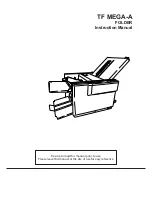
– 46 –
WARNING :
Turn OFF the power before starting the work so as to prevent accidents caused by abrupt start of the sewing machine.
Trouble
Cause (1)
Cause (2)
Checking order and adjusting procedure
From the previous page
1-10) Deffective double
chain-off thread
(only for double
chainstitch)
10-A) Refer to the clause referring to defective
double chain-off thread.
1-11) Threading
11-A) The thread is entangled with the thread
guide, or the looper has been incorrect-
ly threaded.
Refer to the treading diagram.
2. Looper thread breakage
2-1)
Thread path
1-A)
Scratches, burrs, rust, etc, on the paw
of the throat plate, stitch tongue, looper,
looper thread take-up, thread guide, or
tension discs causes friction.
Remove such scratches, burrs, etc. and carry out
thread path finishing. Replace loopers or other
components which have been deformed, causing
thread breakage.
2-2)
Adjustment of the
looper thread take-
up
2-A)
The looper thread take-up or thread
guide has been improperly positioned,
causing excessive thread tension.
Refer to the pertinent Standard Adjustment.
2-3)
Thread tension
3-A)
The looper thread tension is too high.
Reduce the tension while checking the tension
balance other looper thread.
2-4)
Thread
4-A)
The thread is weak because of its poor
quality.
Replace the thread by one with good quality.
2-5)
Position of the
thread guides
5-A)
The upper looper thread guide is too
high, and the thread taking balance is
disturbed, resulting in the thread break-
age.
Refer to the pertinent Standard Adjustment.
2-6)
Double chain looper
avoid (only for dou-
ble chainstitch)
6-A)
The double chain looper strikes the
needle at the back, causing the thread
breakage.
Correct the longitudinal motion of the double
chain looper so as not to cause the looper to
strike the needle.
2-7)
Needle heat
7-A)
The needle gets hot, and the looper
thread breaks when it comes in contact
with the hot needle at the time of needle
stop.
Refer to the clause relating to the needle heat
causing needle thread breakage.















































